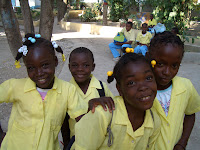After spending time with the babies, I moved onto the older children. That was lots of fun. These kids seemed to be between 3 or 4 and 10. All looked younger than they actually were -- apparantly the result of undernourishment. One little girl was 10 but looked maybe 6 or 7. She sat in my lap and didn't want to leave, and she was thoroughly enjoying counting with me from 1 to 100 in Creole. She was leading, and I was copying...like "1," "1," "2," 2," etc. Of course I don't know any Creole, but it is very similar to French (which I don't know either!). However, both of my sisters took French and I picked up a few words here and there, including numbers up to 10, and some higher numbers, enough that I could follow along with where this girl was leading and could tell that she was "helping" me count to 100. When we got there we did high-5's and she was sooo pleased with herself! And then did it again :)
Finally I managed to get her out of my lap and got the idea to sing some songs with the kids. When I arrived in that room, the hospital staff had been singing "Frere Jacques" and "Allouette, je te allouette" (spelling?), and so Jack and Father Richard and I sang along with them. When they stopped singing, I thought, what can we sing that would be fun for them, given that they don't understand English and I don't know any more French songs? So I put on my best preschool-parent hat and we engaged the kids in Ring Around the Rosy, Itsy Bisty Spider, the Hokey Pokey, and Mi Cuerpo (a Spanish song that Peter learned in preschool). Basically everything I could think of that involved body movements. And the kids loved it! They kept wanting more, more, more. (I was wishing I had asked Peter's teachers and/or my sister for some other song ideas.) It was really fun -- Jack (who is 80-something and reminds me of my grandfather) and I were totally engaged in having fun with these kids, who really need some joy in their lives. After we tired of singing, I started doing the "swinging game" and "dipping game" -- 2 things I invented with my kids, which basically involve alot of arm and back strenth to swing a 40 pound child between your legs, and a ton of fun and squeals for the kids. Some of these kids were much older than Peter, but none was any heavier, so it was manageable. However, after swinging a half-dozen kids with 3 or 4 turns each, and multiple swings each turn, I was pretty tired! At one point I also had one preschooler on my front and one on my back, and was walking around (no sling or Ergo, of course, just my arms which were getting tired!) Somewhere in the mix one of the little boys took my watch off my wrist (an old sports watch) and started playing with it, pushing all the buttons, etc. He was totally engrossed in it -- didn't seem like he'd seen one before, at least not up close. Later I saw him wearing it when they were having snack. I decided to leave the watch with him since he was getting so much joy of out it. Getting a new cheap watch is not a big deal -- but it was a bit challenging managing the rest of the trip without a watch, especially for someone who always likes to know what time it is.
Anyway, it was really fun to engage with these kids -- so far away, whose lives are so different from my own kids' lives -- and see how no matter how different they are in some respects, they are really very much the same. Kids are kids, and they need love and food and good health, and they thrive with attention!















